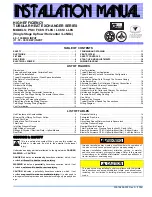
7.1 Troubleshooting confirmations
7-3
7.
Tro
ublesh
ooting
(3) Check for abnormality in the master device (PLC, etc.)
(4) Check the voltage of the main power supply (24 V DC)
Check for momentary power failure, voltage drop, power failure, etc.
(5) Confirm the generated alarm
Check the alarm information with the teaching tool.
(6) Check the connectors for disconnection or incomplete connection
(7) Check the cables for connection error, disconnection or snagging
Cut off the main power supply of the equipment (to avoid electric shock) and remove the
cables around the measurement point (to avoid conductivity through the surrounding
circuit) before checking the conductivity.
(8) Check the I/O signals
Use the master device and ELECYLINDER teaching tool to check for inconsistency or
abnormality in the input/output signal status of the two units.
(9) Check the noise elimination measures (grounding, connection of noise
suppressor, etc.)
(10) Check the events leading to the occurrence of the problem, as well as the
operating conditions at the time of occurrence
(11) Analyze the cause
(12) Countermeasures
Caution
When troubleshooting, exclude normally functioning parts from the targets to narrow
down the causes.
First, check (1) to (10) so that countermeasures can be taken swiftly.
Summary of Contents for ELECYLINDER EC-RTC12
Page 2: ......
Page 26: ...1 5 Accessories 1 35 Power I O cable 1 35 Power I O connector 1 36 ...
Page 64: ......
Page 78: ...2 14 2 Installation ...
Page 80: ......
Page 100: ...3 20 3 Wiring ...
Page 124: ...4 22 4 Operation ...
Page 126: ......
Page 132: ...5 6 5 Preventive Predictive Maintenance ...
Page 134: ......
Page 148: ...6 14 6 Parameters ...
Page 150: ......
Page 168: ...7 18 7 Troubleshooting ...
Page 170: ......
Page 208: ......
Page 212: ......
Page 214: ...10 2 10 Life ...
Page 216: ......
Page 219: ...Appendix 12 1 Index 12 1 12 2 Revision history 12 4 ELECYLINDER Chapter12 ...
Page 220: ......
Page 225: ......
















































